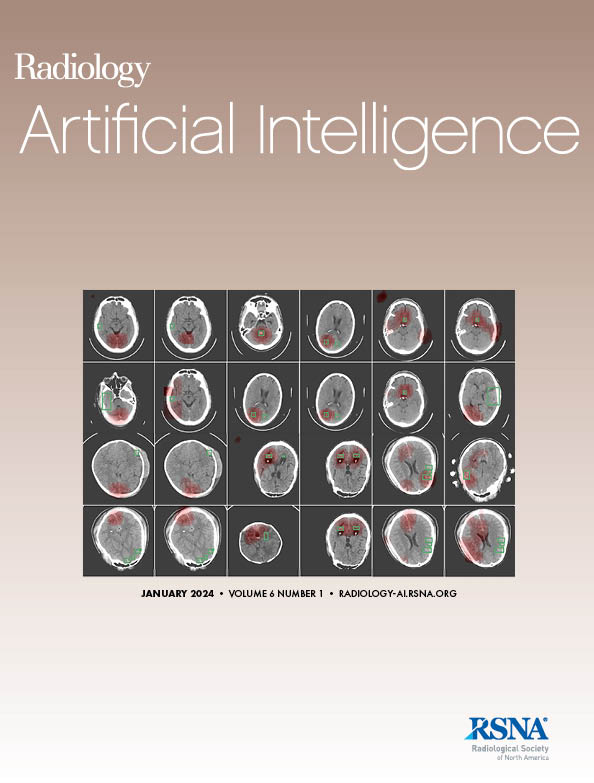Eui Jin Hwang, Hyunsook Hong, Seungyeon Ko, Seung-Jin Yoo, Hyungjin Kim, Dahee Kim, Soon Ho Yoon
求助PDF
{"title":"全自动和人工智能辅助 CT 定量胸腔穿刺术后胸腔积液变化的准确性。","authors":"Eui Jin Hwang, Hyunsook Hong, Seungyeon Ko, Seung-Jin Yoo, Hyungjin Kim, Dahee Kim, Soon Ho Yoon","doi":"10.1148/ryai.240215","DOIUrl":null,"url":null,"abstract":"<p><p>Quantifying pleural effusion change at chest CT is important for evaluating disease severity and treatment response. The purpose of this study was to assess the accuracy of artificial intelligence (AI)-based volume quantification of pleural effusion change on CT images, using the volume of drained fluid as the reference standard. Seventy-nine participants (mean age ± SD, 65 years ± 13; 47 male) undergoing thoracentesis were prospectively enrolled from October 2021 to September 2023. Chest CT scans were obtained just before and after thoracentesis. The volume of pleural fluid on each CT scan, with the difference representing the drained fluid volume, was measured by automated segmentation (fully automated measurement). An expert thoracic radiologist then manually corrected these automated volume measurements (human-assisted measurement). Both fully automated (median percentage error, 13.1%; maximum estimated 95% error, 708 mL) and human-assisted measurements (median percentage error, 10.9%; maximum estimated 95% error, 312 mL) systematically underestimated the volume of drained fluid, beyond the equivalence margin. The magnitude of underestimation increased proportionally to the drainage volume. Agreements between fully automated and human-assisted measurements (intraclass correlation coefficient [ICC], 0.99) and the test-retest reliability of fully automated (ICC, 0.995) and human-assisted (ICC, 0.997) measurements were excellent. These results highlight a potential systematic discrepancy between AI segmentation-based CT quantification of pleural effusion volume change and actual volume change. <b>Keywords:</b> CT-Quantitative, Thorax, Pleura, Segmentation Clinical Research Information Service registration no. KCT0006683 <i>Supplemental material is available for this article.</i> © RSNA, 2025.</p>","PeriodicalId":29787,"journal":{"name":"Radiology-Artificial Intelligence","volume":" ","pages":"e240215"},"PeriodicalIF":13.2000,"publicationDate":"2025-01-01","publicationTypes":"Journal Article","fieldsOfStudy":null,"isOpenAccess":false,"openAccessPdf":"","citationCount":"0","resultStr":"{\"title\":\"Accuracy of Fully Automated and Human-assisted Artificial Intelligence-based CT Quantification of Pleural Effusion Changes after Thoracentesis.\",\"authors\":\"Eui Jin Hwang, Hyunsook Hong, Seungyeon Ko, Seung-Jin Yoo, Hyungjin Kim, Dahee Kim, Soon Ho Yoon\",\"doi\":\"10.1148/ryai.240215\",\"DOIUrl\":null,\"url\":null,\"abstract\":\"<p><p>Quantifying pleural effusion change at chest CT is important for evaluating disease severity and treatment response. The purpose of this study was to assess the accuracy of artificial intelligence (AI)-based volume quantification of pleural effusion change on CT images, using the volume of drained fluid as the reference standard. Seventy-nine participants (mean age ± SD, 65 years ± 13; 47 male) undergoing thoracentesis were prospectively enrolled from October 2021 to September 2023. Chest CT scans were obtained just before and after thoracentesis. The volume of pleural fluid on each CT scan, with the difference representing the drained fluid volume, was measured by automated segmentation (fully automated measurement). An expert thoracic radiologist then manually corrected these automated volume measurements (human-assisted measurement). Both fully automated (median percentage error, 13.1%; maximum estimated 95% error, 708 mL) and human-assisted measurements (median percentage error, 10.9%; maximum estimated 95% error, 312 mL) systematically underestimated the volume of drained fluid, beyond the equivalence margin. The magnitude of underestimation increased proportionally to the drainage volume. Agreements between fully automated and human-assisted measurements (intraclass correlation coefficient [ICC], 0.99) and the test-retest reliability of fully automated (ICC, 0.995) and human-assisted (ICC, 0.997) measurements were excellent. These results highlight a potential systematic discrepancy between AI segmentation-based CT quantification of pleural effusion volume change and actual volume change. <b>Keywords:</b> CT-Quantitative, Thorax, Pleura, Segmentation Clinical Research Information Service registration no. KCT0006683 <i>Supplemental material is available for this article.</i> © RSNA, 2025.</p>\",\"PeriodicalId\":29787,\"journal\":{\"name\":\"Radiology-Artificial Intelligence\",\"volume\":\" \",\"pages\":\"e240215\"},\"PeriodicalIF\":13.2000,\"publicationDate\":\"2025-01-01\",\"publicationTypes\":\"Journal Article\",\"fieldsOfStudy\":null,\"isOpenAccess\":false,\"openAccessPdf\":\"\",\"citationCount\":\"0\",\"resultStr\":null,\"platform\":\"Semanticscholar\",\"paperid\":null,\"PeriodicalName\":\"Radiology-Artificial Intelligence\",\"FirstCategoryId\":\"1085\",\"ListUrlMain\":\"https://doi.org/10.1148/ryai.240215\",\"RegionNum\":0,\"RegionCategory\":null,\"ArticlePicture\":[],\"TitleCN\":null,\"AbstractTextCN\":null,\"PMCID\":null,\"EPubDate\":\"\",\"PubModel\":\"\",\"JCR\":\"Q1\",\"JCRName\":\"COMPUTER SCIENCE, ARTIFICIAL INTELLIGENCE\",\"Score\":null,\"Total\":0}","platform":"Semanticscholar","paperid":null,"PeriodicalName":"Radiology-Artificial Intelligence","FirstCategoryId":"1085","ListUrlMain":"https://doi.org/10.1148/ryai.240215","RegionNum":0,"RegionCategory":null,"ArticlePicture":[],"TitleCN":null,"AbstractTextCN":null,"PMCID":null,"EPubDate":"","PubModel":"","JCR":"Q1","JCRName":"COMPUTER SCIENCE, ARTIFICIAL INTELLIGENCE","Score":null,"Total":0}
引用次数: 0
引用
批量引用

 求助内容:
求助内容: 应助结果提醒方式:
应助结果提醒方式:


